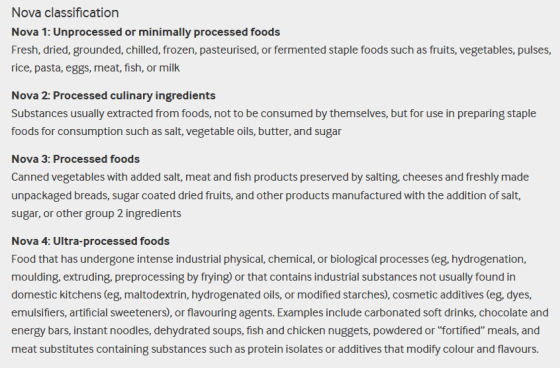In conversations about nutrition and health, ultra-processed foods (UPFs) often come up. In fact, earlier this year, a large review was published linking high intake of ultra-processed foods and certain health conditions, including heart disease, type-2 diabetes, anxiety, and depression. This certainly gives the impression that UPFs cannot and should not be part of a healthy lifestyle. But…are they all bad?
Let’s first define UPFs. Ultra-processed foods are part of the NOVA food classification system, which categorizes food according to the type, intensity, and purpose of food processing. It’s worth noting, nutrition value of a food plays no role in the categorization.
The 4 groups are:
- Nova 1: Unprocessed or minimally processed foods
- Nova 2: Processed culinary ingredients
- Nova 3: Processed foods
- Nova 4: Ultra-processed foods

Source: https://www.bmj.com/content/383/bmj-2023-075294
Ultra-processed foods include things like soda, chips, and hot dogs – all of which do not contribute much nutritional value to the daily diet. However, UPFs also include infant formula, plant milks, packaged breads, and cereal. Many of these foods contribute very healthful nutrients like calcium, vitamin D, fiber, iron, and nutrients necessary for infant growth and brain development.
What about the research that is essentially vilifying all these foods? The umbrella review looked at nearly 10 million people in 14 meta-analysis studies and 45 pooled analyses. Researchers found “higher dietary exposure to ultra-processed foods was associated with a higher risk of adverse health outcomes in 32 out of 45 pooled analyses.”
The downfall? This type of food grouping clumps together vastly different foods – such as toaster pastries and multigrain bread – as the same. However, we know some provide valuable nutrients, especially to those who reside in food deserts or with limited access to food stores.
So instead of thinking we should just ditch it all, here are my 3 tips for achieving a healthy balance of processed and unprocessed foods:
- Reduce the reach. Identify the ultra-processed foods you buy regularly. Then choose 1-2 that could be swapped out for a less processed version. For example, switch flavored yogurt for unflavored, or maple brown sugar oatmeal for plain rolled oats. You don’t have to change everything! Even a few healthy swaps can leave you feeling good without the ‘all or nothing’ mentality.
- Get cookin’! Increase how often you cook at home, and use whole or minimally processed ingredients. This gives us more control in the quality of our snacks and meals.
- Up your fruit and vegetable game. Because UPFs tend to be lower in fiber and higher in sugars, fat, and salt than their wholesome counterparts, we are more inclined to overeat. To keep portions in check, include a fruit and/or vegetable with all snacks and meals. This ensures we are getting valuable fiber, vitamins, minerals, and antioxidants every day!
Erin Pellegrin, RD, LDN
Sources:
https://doi.org/10.1136/bmj-2023-075294
https://doi.org/10.1136/bmj-2023-077310
https://jamanetwork.com/journals/jama/fullarticle/2782866

